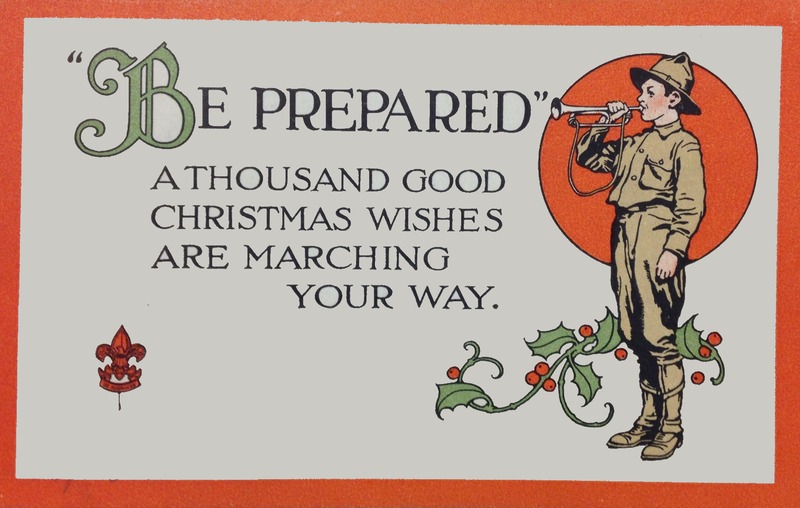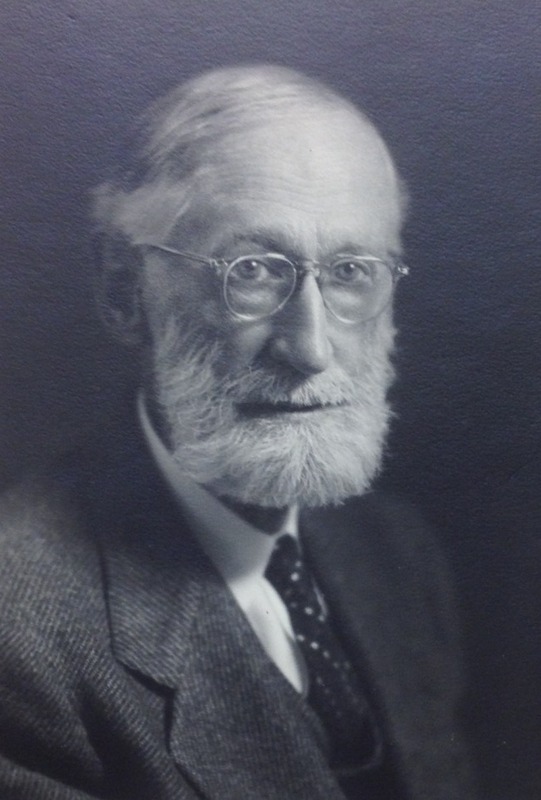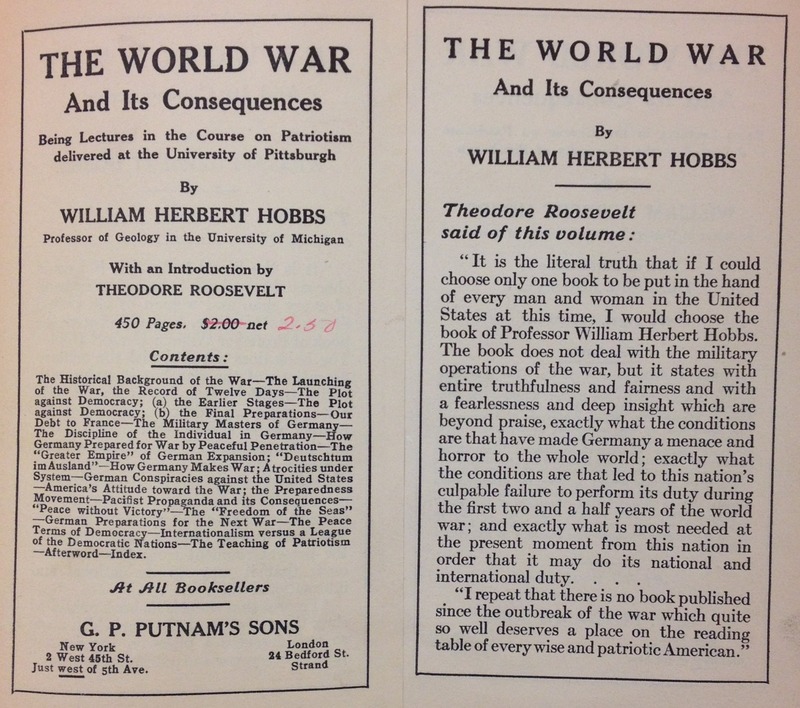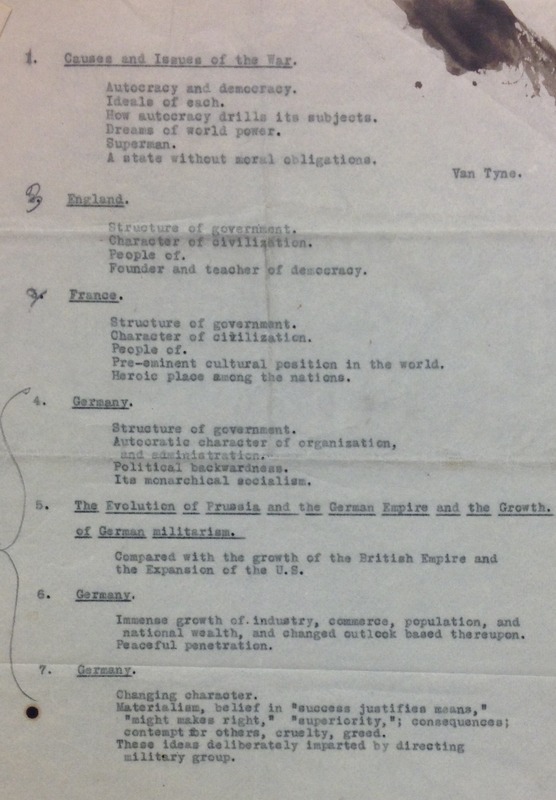War Preparedness Debates
 On September 2, 1914, the Michigan Daily announced that it would remain neutral in the European War. The student paper followed the national sentiments. But it did not take long for a heated debate over the United States' military preparedness, and the role of the university in contributing to it played out on its pages. U-M's regents had repeatedly rejected preliminary proposals for military and war preparedness on campus. But a handful of interventionist hawks within the faculty had been loudly calling for the university to fund compulsory training, and students were beginning to listen. The discussions were coupled with a growing anti-German sentiment on campus. As early as February 1915, General Leonard Wood and Admiral Robert Peary came to Michigan’s Hill Auditorium to hold a talk on the issue of German belligerence and war preparedness. By October of the same year, William Herbert Hobbs, a professor of geology, had founded the University of Michigan’s chapter of the National Security League [NSL].
On September 2, 1914, the Michigan Daily announced that it would remain neutral in the European War. The student paper followed the national sentiments. But it did not take long for a heated debate over the United States' military preparedness, and the role of the university in contributing to it played out on its pages. U-M's regents had repeatedly rejected preliminary proposals for military and war preparedness on campus. But a handful of interventionist hawks within the faculty had been loudly calling for the university to fund compulsory training, and students were beginning to listen. The discussions were coupled with a growing anti-German sentiment on campus. As early as February 1915, General Leonard Wood and Admiral Robert Peary came to Michigan’s Hill Auditorium to hold a talk on the issue of German belligerence and war preparedness. By October of the same year, William Herbert Hobbs, a professor of geology, had founded the University of Michigan’s chapter of the National Security League [NSL].
The NSL’s militarist and anti-German rallies gathered the support of many prominent Michigan faculty members, including Emeritus President James Burrill Angell, Dean Mortimer E. Cooley, Dean Victor C. Vaughan, and Dean Henry M. Bates. The NSL promoted compulsory military service and encouraged many students to become to volunteers in the armed forces while simultaneously deriding pacifist voices on campus. The NSL's activities were not just limited to campus. It was a national organization that received the support of business leaders, private and public institutions, and several influential political figures, such as Theodore Roosevelt. At the University of Michigan, the NSL developed a fierce following, spearheaded by Hobbs, which became a perpetual component of war debates on campus and in the student paper the Michigan Daily.
Hobbs in particular became a major voice for the NSL, writing an entire book on the issue of war preparedness with an introduction from Theodore Roosevelt, who declared that “if I could choose only one book to be put in the hands of every man and woman in the United States at this time, I would choose the book of William Herbert Hobbs” [1]. Hobbs also arranged for several more rallies at Hill Auditorium in the spring of 1916, including the return of General Leonard Wood [2]. Hobbs and his friend, Professor of History Claude Halstead Van Tyne, had argued since the outbreak of the war against pacifism, which they saw as a seed planted by German sympathizers to keep the United States out of war [3]. While Hobbs was more concerned with uncovering plots of assiduous German activity on campus, Van Tyne deconstructed pro-German sentiment in America as misplaced and historically unfounded [4]. Instead of sympathizing with German autocracy, Van Tyne argued, Americans should support the democratic ideals promoted by the allies. However, as Hobbs and Van Tyne ramped up their prowar activities, complications and resentment of NSL activities arose as well.
After American entry into the war, the issue of loyalties and patriotism within the university’s German department became a major debate across campus. A group of alumni wrote to President Hutchins and the Board of Regents to remove several important faculty of the German department who had been deemed particularly seditious. Professor Carl E. Eggert was the first marked for dismissal. In a meeting with regents, Hobbs testified that he witnessed Eggert make numerous pro-German remarks in the classroom [5]. This event only exacerbated the debate on campus. Several faculty members saw the increasing involvement of the NSL on campus as a threat to the school’s academic integrity. Both President Hutchins and Dean Alfred Lloyd admonished Hobbs in particular and sought to have him censured for continually suggesting the existence of a formal bond between the university and the NSL [6]. However, Hobbs had many supporters in the faculty senate who had the resolution to censure him tabled, securing his position on campus. Hutchins and Lloyd’s attempt to separate war preparedness activities from official university activities was not uncommon across the United States. Both the president of Harvard University and the president of the University of Vermont succeeded in keeping their German departments intact, despite the outcry of alumni and their withdrawal of donations [7]. The University of Michigan was however particularly susceptible to the influence of alumni and anti-German propaganda, and the internal debate surrounding the war would linger even after the armistice of 1918.
By the spring of 1918, the war had become increasingly entangled in the lives of both students and faculty at the University of Michigan. As a part of the national program for war preparedness among colleges around the nation, Michigan required students to take their version of the federally mandated “War Issues Course.” The class focused on educating students about the war, including its history and its causes. The War Issues Course was a propaganda tool designed to place the blame for the war squarely on Germany [8]. None other than Claude Halstead Van Tyne designed the course [9]. Similar to other War Issues Courses at institutions like the University of Chicago, Michigan’s class departed from usual standards of academic rigor and examined the war from a moral perspective. The course was not only designed to be easier than ordinary college courses but also avoided historical controversies to maintain the Allies’ status of having the moral high ground in the war [10]. Van Tyne’s course lambasted Germany as a cruel autocratic state of tyranny. Moreover, he alerted that pacifists inside America were “drunk with the wine of freedom, frenzied with freedom, joy-riding with liberty,” and impose “their reeling gait upon Americans to whom freedom had been a refreshing stream for upwards of 150 years” [11]. In finding neutrality dichotomous with liberty and morality a central component of the war, Van Tyne broke ways with standard methods of historical analysis. In his choice to foster among students a narrow and pointed understanding of the war, Van Tyne’s War Issues Course served as more of an element of prowar propaganda than an academic understanding of the war.
Backing the war effort became a patriotic duty. In addition to the War Issues Course, the University administration established the Reserve Officer’s Training Corps ( ROTC) in March 1916. Still the Board of Regents was hesitant and resisted implementing the program until it could be lead by a qualified officer of the military. The University of Michigan officially joined forces with the US Army to form the Students’ Army Training Corps (SATC), which utilized university resources to train student volunteers in areas of the military that demanded expertise. A large concern of the university quickly became maintaining enrollment, as students were urged to finish their education before joining up.
Notes
Please click images for full descriptions and citations
[1] William Herbert Hobbs, The World War and Its Consequences (New York, NY.: G. P. Putnam’s Sons, 1919), XIV.
[2] Howard H. Peckham, The Making of the University of Michigan, 1817-1992 (Ann Arbor, MI.: University of Michigan, Bentley Historical Library, 1994), 141.
[3] William Herbert Hobbs Papers, Box 1, Bentley Historical Library, University of Michigan.
[4] Claude H. Van Tyne, “Democracy's Educational Problem," Michigan History Magazine, vol. 3, no. 1 (Jan. 1919), 82-92.
[5] Clifford Wilcox, "World War I and the Attack on Professors of German at the University of Michigan," (University of Michigan, May 1992), 5.
[6] Ibid., 15.
[7] Ibid., 22.
[8] David Kennedy, Over Here: The First World War and American Society, (New York: Oxford University Press, 1980), 57.
[9] The Michigan Alumnus, vol. 25, no. 237 (Ann Arbor, MI: University of Michigan, 1919), 3.
[10] Kennedy, Over Here, 58.
[11] Claude Halstead Van Tyne Papers, Box 4, Bentley Historical Library, University of Michigan.




